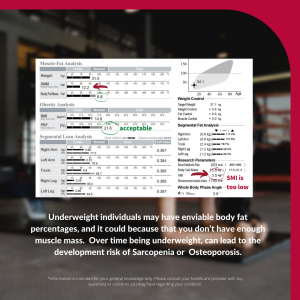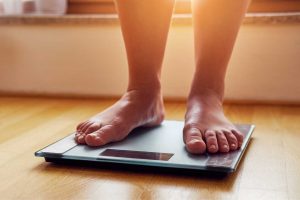If you’re using body composition tools like calipers to measure your body fat percentage to assess your health, then you’re already ahead of most (like those who are still using BMI).
But be aware that body fat percentage doesn’t always paint a complete picture when it comes to body composition. What’s more, decreases in your body fat percentage don’t always mean fat loss. That’s because body fat percentage is a simple equation of your fat mass divided by your total weight.
Percentage Body Fat = Body Fat Mass / Total Body Weight
In some ways, body fat percentage is the most basic of all body composition results, because it only requires your Fat, Fat-Free Mass (or Lean Body Mass), and total weight.
While fat and fat-free mass are enough to give you a body fat percentage value, it isn’t always enough to explain changes in body fat percentages or give enough information to determine whether your body fat levels are healthy. You will get much more context about what your body fat percentage means if you look at it alongside things like Skeletal Muscle Mass. These are the muscles in your body that you can grow and develop through exercise.
Without assessing your amount of Skeletal Muscle Mass, your body composition assessments are going to be incomplete. You won’t be able to fully understand the changes in your body fat percentage, and you may also be misled by what your body fat percentage means. Here are a few examples:
1. You’re working out, but body fat percentage doesn’t change (or increases)
This situation can occur when you are working out to gain muscle in order to improve your physique, but you aren’t seeing the changes in the mirror that you hoped to see as quickly as you’d like. When you check your body fat percentage, you don’t see any change despite a month of hard workouts. What’s going on?
The first thing to check is to see if your weight has changed. It probably has. If your weight has increased but your body fat percentage remains unchanged, this likely means that your SMM is increasing at the same time as your Fat Mass. As you increase musculature, fat gain can occur due to the caloric surpluses required to increase SMM. This is a well-recognized phenomenon and is commonly referred to in gym-speak as “bulking.”

Additionally, situations can occur in which after initial drops in body fat percentage, the percentage rises right back where it used to be after a couple months. Why?
This is because your body has entered what is referred to as an anabolic state – the condition in which your body increases muscle production. Your body will require more calories than what you’re used to in order to build more muscle than it had before.
Not all of these calories, however, are going toward muscle development. Being in a calorie surplus can lead to fat gain as well, which can cause an increase in body fat percentage.
2. You’re Losing Weight, But Your Body Fat % Doesn’t Change (or increases)
Similar to #1, this situation also involves little or no change in body fat percentage but instead of occurring due to anabolism, this time, catabolism is the driving force behind the change.
In catabolism, the body is focused on reducing tissue, not building it. In order to lose weight, especially fat, the body should be in a catabolic state; in order to be in a catabolic state, the body needs to be in a caloric deficit (taking in fewer calories than needed). In gym speak, this is referred to as “cutting.”
If you observe that you’re losing weight, but you don’t see the results in the mirror that you’d like to see and notice that your body fat percentage is unchanged, this is because your SMM and Fat Mass are actually decreasing together.

Why would Skeletal Muscle Mass decrease when you’re trying to target body fat only? Although there isn’t a singular cause, the majority of the time this is caused by improper training and diet.
Most weight loss is a combination of body fat and skeletal muscle. That much is unavoidable. For this reason, preserving or even increasing muscle becomes a priority when encouraging the body to enter a catabolic state. This means ensuring your nutrient intake is balanced while engaging in some kind of resistance or weight training.
Many people neglect these important precautions and cause their body to metabolize muscle as well as fat. Depending on how much muscle is lost, body fat percentages can drop extremely slowly, stay the same, or in extreme circumstances, increase.
3. Your Body Fat Percentage is Acceptable, But You’re Underweight
At first, this doesn’t seem like it makes sense – how can you be at a healthy body fat percentage, but not be healthy overall? Simple: you’re underweight.

Underweight individuals may have enviable body fat percentages which can lead some people into believing that they are healthier than they actually are. However, if you are underweight, this means that you don’t have enough muscle mass. Being underweight doesn’t get as much popular attention as being overweight does, but over time, being underweight can lead to the development of osteoporosis, which is diagnosed when a person has low bone density.
Not having enough muscle mass will also become problematic if you get sick. When you become sick, the body’s need for amino acids to power its immune and recovery processes increases, and it will look to your muscle mass for those amino acids. Essentially, your body will start to break down muscle in order to fight and recover from disease, and if you’re underweight with a healthy body fat percentage, you won’t have enough muscle to easily fight off illness.
4. Your Body Fat Percentage is Acceptable, But You Have Muscle Imbalances
Even if you are at a healthy weight and have an acceptable body fat percentage, only having Fat and Fat-Free Mass as results can hide potential issues. Because Fat-Free Mass is a catchall term for everything in your body that isn’t attributed to fat, an absolute value for Fat-Free Mass can’t describe how well developed this mass is in terms of your overall body composition. In order to see that, you would need to take a closer look at how this mass is distributed segmentally.
Specifically, people can have well developed Lean Body Mass areas in some parts of their bodies but not in others. Some people prefer developing upper body muscle while neglecting lower body muscle development. Others may have what’s referred to as a bilateral imbalance, which occurs when one side of the body is stronger than the other. Here’s what that looks like from a body composition analysis viewpoint:

In this example, this person has almost one pound of muscle difference between their right and left arm. Although this might seem more of an aesthetic problem, significant muscle imbalances such as the one shown above can also contribute towards injury. Shoulder muscle imbalances in volleyball players, for example, have been shown to increase the onset of shoulder pain and injury.
It’s Just One Number
Although your body fat percentage is a very significant and useful number, relying on any one number, even an important number like body fat percentage, will never provide you with a complete picture about your overall health. While body fat percentage is a very good way to assess your weight, it only takes Body Fat (and by extension Fat-Free) Mass and Weight into account.
In order to maintain your weight and understand the changes that your body experiences over time, including your change in body fat percentage, you will need more specific values than just Fat and Fat-Free Mass. If you don’t compare your body fat percentage to Skeletal Muscle Mass, you won’t be able to:
- Understand increases and decreases in body fat percentage
- Maintain a healthy body fat percentage in respect to a healthy weight and muscle mass level
- Determine if your muscles are balanced
Your body is a very complex system of many components all working together. That is why it is very important to get as much information as possible in order to understand your weight and your health properly. Calipers are a good a start, but in order to assess whether you have a healthy body composition try devices like a DSM-BIA device, that will go beyond body fat percentage and give you your muscle mass and body water results.




















































